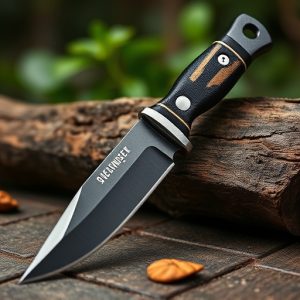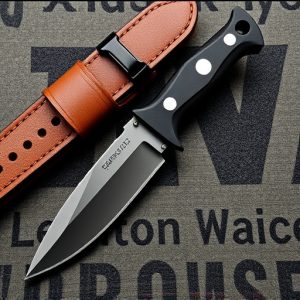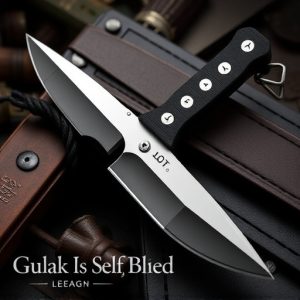Mastering the Fixed Blade Self-Defense Knife: Selection, Use, and Legalities
A fixed blade self-defense knife is a reliable tool for personal protection, offering durability an…….
A fixed blade self-defense knife is a reliable tool for personal protection, offering durability and dependability in critical situations. When choosing one, consider factors like hand size, grip type, task intended, blade length and shape, and personal preference. The optimal knife should have a balance of effectiveness and legality, typically between two and four inches, and be made from resilient steels such as CPM S35VN or VG-10 for edge retention and corrosion resistance. Blade geometry, like a drop point or Tanto profile, affects adaptability and strength. An ergonomic handle ensures a secure grip in various conditions, while a full tang structure enhances robustness. Safety features, including a finger guard and a retention system within a sturdy sheath, are essential for secure carrying and swift deployment. Regular cleaning, sharpening, and training with the knife are necessary to maintain its readiness and effectiveness. It's important to be aware of legal requirements and ethical considerations when possessing and using a fixed blade self-defense knife, as well as to stay within the bounds of societal norms and local laws. Training with the knife is crucial for familiarity and proficiency, ensuring it functions optimally in defensive scenarios. Maintaining the knife's sharpness through proper sharpening methods is vital to prevent unintended harm. Regular handling, simulating real-life defensive situations, and understanding legal considerations will prepare users to effectively utilize their fixed blade self-defense knife when confronted with a threat.
When considering personal safety, a fixed blade self-defense knife emerges as a reliable tool. This article delves into the essential aspects of selecting and using this versatile device effectively. From discerning the key features that constitute a high-quality fixed blade to understanding its anatomy—including blade shapes, materials, and ergonomics—we explore the technicalities for informed decision-making. Moreover, we address the legal boundaries and ethical weight of knife ownership. Additionally, practical advice on training and maintaining your knife ensures you are prepared and compliant. Engage with this comprehensive guide to master the art of self-defense with a fixed blade knife.
Understanding the Fixed Blade Self-Defense Knife: A Primer on Selection and Use
When considering a fixed blade self-defense knife, it’s crucial to understand its design, functionality, and legal implications. A fixed blade, unlike its folding counterpart, offers unrivaled durability and reliability, making it a staple in self-defense arsenals for its dependable performance when every second counts. The selection of a fixed blade self-defense knife should be based on several factors: the user’s hand size, the type of grip desired, the nature of the tasks it will perform, and personal preferences regarding the blade’s length and shape.
For optimal use, the knife should complement your hand size to ensure a secure and natural grip, which is essential for precision and control. The blade’s edge should be sharp yet not overly so as to avoid accidental cuts or injury during deployment. When it comes to the blade’s length, a balance must be struck between effectiveness in self-defense situations and ease of handling. Typically, blades ranging from two to four inches are recommended for everyday carry and self-defense due to their versatility and legality in most jurisdictions. Always prioritize a knife with a full tang construction for superior strength and durability, and consider the materials used—stainless steel, for instance, is an excellent choice due to its resistance to corrosion and retention of sharpness over time. Regular maintenance, including cleaning and sharpening, will ensure your fixed blade self-defense knife remains a reliable tool when you need it most.
Key Features of a High-Quality Fixed Blade Self-Defense Knife
A high-quality fixed blade self-defense knife is a critical tool for personal safety, combining durability, ergonomics, and functionality to ensure it’s up to the task when you need it most. The blade of such a knife should be made from premium steel, like CPM S35VN or VG-10, which offers exceptional edge retention, corrosion resistance, and ease of sharpening. This ensures that the knife remains sharp and ready for use over time, even under the demanding conditions it may face. The blade geometry is another key feature; a drop point or Tanto shape is often preferred due to their balance of strength and versatility in various self-defense scenarios.
Ergonomic handle design is paramount, as it allows for a secure grip that can withstand the stress of defensive situations without slipping, even when hands are sweaty or wet. The handle should also provide a comfortable and natural grip to enable precise control during deployment and use. A full tang construction ensures the knife’s strength and durability, with no weak points where the blade meets the handle. Additionally, features such as a finger guard protect the user from accidental cuts and blunts, and a sturdy sheath with a secure retention system is essential for safe carrying and quick access when needed. The combination of these elements in a fixed blade self-defense knife ensures it’s a reliable companion for personal protection.
The Anatomy of a Fixed Blade Self-Defense Knife: Blade Shapes, Materials, and Ergonomics
When considering a fixed blade self-defense knife, understanding its anatomy is crucial for effectiveness and safety. The blade shape is one of the most significant factors, as it determines the knife’s intended use and performance. Common shapes include the drop-point, which offers versatility and a strong tip for precise punctures; the Tanto, known for its durable tip and robust point; and the clip-point, which provides a sharp, pointed end ideal for piercing. Each shape caters to different self-defense scenarios, allowing users to select the one that best aligns with their self-defense strategy and training.
In terms of materials, high-quality steel is essential for durability and edge retention. Steels like CPM S35VN or VG-10 are popular choices due to their ability to maintain an edge under stress while being resistant to corrosion. The handle ergonomics complement the blade by ensuring a secure grip in various conditions, reducing the likelihood of the knife slipping from your grasp during self-defense situations. An ergonomic design also minimizes fatigue over extended use and can be tailored to fit different hand sizes for optimal control. The balance between the handle and blade is another critical aspect, as it influences how the knife behaves in the hand and upon impact. A well-balanced knife can enhance precision and control, making it a reliable tool in self-defense scenarios. Attention to these details ensures that the fixed blade self-defense knife serves its purpose effectively when used for personal protection.
Legal Considerations and Ethical Responsibilities When Carrying a Fixed Blade Self-Defense Knife
When considering a fixed blade self-defense knife, individuals must be acutely aware of the legal framework and ethical implications governing its use. The legality of carrying such a knife varies by jurisdiction, with specific laws dictating allowable blade lengths, restrictions on certain locations, and requirements for obtaining a concealed carry permit if applicable. It is imperative to research and understand these local ordinances to avoid unintentional legal infractions that could result in fines or imprisonment. Beyond legality, the ethical responsibility of using a fixed blade knife in self-defense cannot be overstated. The decision to deploy a knife in a confrontation should be a last resort, after less aggressive measures have been attempted or are not feasible. Ethically, one must consider the potential consequences of using deadly force, including the physical and psychological impact on both the perpetrator and oneself. Proper training in the use of a fixed blade knife is essential to ensure that it is used responsibly and effectively for self-defense, minimizing the risk of harm to oneself or others. This training should encompass not only the technical skills of knife handling but also a thorough understanding of ethical self-defense principles, ensuring that the use of such a tool aligns with societal expectations and moral standards.
Practical Tips for Training and Maintaining Your Fixed Blade Self-Defense Knife
When integrating a fixed blade self-defense knife into your routine, it’s crucial to engage in regular training and maintenance to ensure its efficacy when needed. Firstly, prioritize handling your knife daily; this familiarity will make it an extension of your hand during critical moments. Practice various grips to gain confidence in controlling the blade under pressure. Next, develop a regimen that includes sharpness testing and honing the edge regularly. A dull knife can be more dangerous than none at all, as it may slip from its intended target. Use a ceramic rod or sharpening stones to maintain the blade’s cutting ability; most fixed blades come with recommended instructions on how to properly sharpen them.
Additionally, consider training with your knife in controlled environments to simulate real-life scenarios. This practice should encompass defensive maneuvers, disarming techniques, and learning to use the knife for cutting tasks to understand its capabilities and limitations. Regularly clean your knife after each use with a suitable cleaning solution to prevent corrosion and remove any biological matter that could compromise its condition over time. Lubricate pivots and moving parts to ensure they remain smooth and functional. By adhering to these practical tips for training and maintaining your fixed blade self-defense knife, you’ll be better prepared to rely on it in a self-defense situation. Remember to stay informed about local laws regarding the carry and use of such tools to avoid legal complications.


